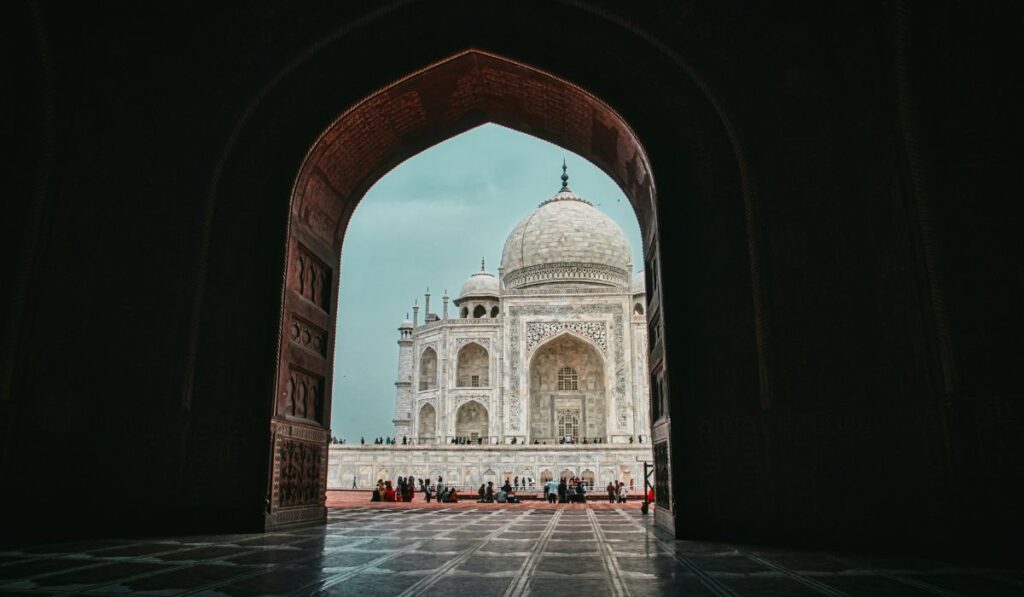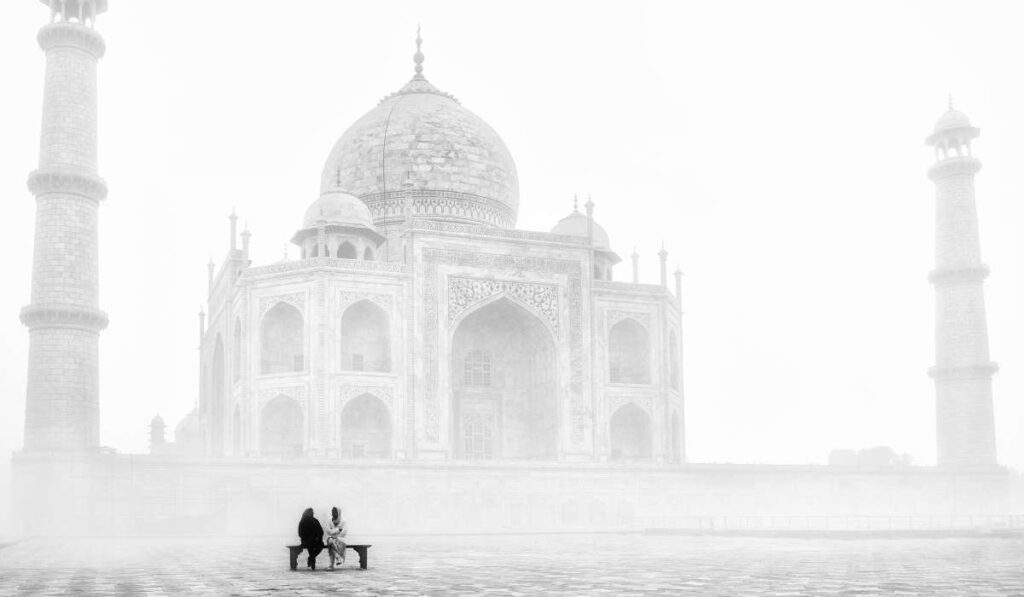The Taj Mahal is one of the most iconic landmarks in the world and a timeless symbol of love. Located in Agra, India, this stunning monument is not only a masterpiece of Mughal architecture but also a representation of devotion and artistry that has stood the test of time. Often described as a “Poem in Stone” and a “Dream in Marble,” the Taj Mahal continues to enchant millions of travelers every year.
Built in the 17th century by Mughal Emperor Shah Jahan in memory of his beloved wife Mumtaz Mahal, the Taj Mahal reflects the grandeur of the Mughal Empire and the rich cultural heritage of India. Today, it is recognized as one of the New Seven Wonders of the World and a UNESCO World Heritage Site, making it an essential destination for anyone visiting India.
The Story Behind the Taj Mahal – A Legacy of Love

The charm of the Taj Mahal is not only in its architecture but also in the emotional story it carries. Mumtaz Mahal, the favorite wife of Shah Jahan, passed away in 1631 during childbirth. Stricken by grief, Shah Jahan envisioned a mausoleum so beautiful that it would immortalize their love.
Construction of the Taj Mahal began in 1632 and continued for over 20 years. More than 20,000 artisans, laborers, and craftsmen, under the guidance of skilled architects, worked to bring this vision to life. Materials were sourced from all over India and Central Asia, with the gleaming white marble transported from Makrana in Rajasthan.
The result was a mausoleum that was not only breathtaking but also deeply symbolic—every detail carefully designed to express harmony, symmetry, and eternal love.
A Marvel of Architecture
The Taj Mahal’s architecture is one of the finest examples of Mughal craftsmanship. It blends Indian, Persian, and Islamic styles to create a masterpiece of balance and proportion.
Key Architectural Highlights:
- The White Marble Dome: Rising majestically to 240 feet, the central dome is the most striking feature, often glowing golden at sunrise and pink at sunset.
- Four Minarets: Positioned at each corner, they lean slightly outward, a design that protects the main tomb in case of an earthquake.
- Pietra Dura Inlay Work: Intricate floral designs created with semi-precious stones, such as jade, turquoise, and lapis lazuli, enhance the marble walls.
- Mughal Gardens: Inspired by Persian garden layouts, the charbagh (four-part garden) with fountains and reflecting pools symbolizes paradise on earth.
- Symmetry and Balance: Every element of the complex—from gateways to minarets—is perfectly symmetrical, showcasing the Mughal mastery of design.
This harmony of design is why the Taj Mahal is often called an architectural “wonder of the world.”
Taj Mahal – A UNESCO World Heritage Site
In 1983, UNESCO declared the Taj Mahal a World Heritage Site, recognizing its cultural significance and universal value. Since then, it has been carefully preserved, with strict rules for visitor management, environmental controls, and conservation efforts.
Today, it remains one of the most visited sites in India, attracting over 8 million tourists annually. For travelers, standing before the Taj Mahal is not just a sightseeing experience—it is a moment of awe, where history, art, and love come together.

Best Times to Visit the Taj Mahal
The Taj Mahal is breathtaking at any time of the day, but certain moments make it even more magical:
- Sunrise: The white marble glows golden in the morning light. The Taj Mahal Sunrise Tour is highly recommended for photographers and peace-seekers.
- Sunset: As the sun sets, the monument turns a soft pink, creating a romantic ambiance.
- Full Moon Nights: On special nights, visitors can witness the Moonlight View of the Taj Mahal, where the marble shimmers under the silver glow of the moon.
The best season to visit is between October and March, when the weather is cool and pleasant.
Things to Do Around the Taj Mahal
While the Taj Mahal is the centerpiece, Agra offers other historical treasures worth exploring:
- Agra Fort – A UNESCO site and former residence of Mughal emperors, located just 2.5 km from the Taj Mahal.
- Mehtab Bagh – A garden across the Yamuna River, famous for sunset views of the Taj.
- Itimad-ud-Daulah (Baby Taj) – A beautiful marble tomb that inspired the Taj Mahal’s design.
- Fatehpur Sikri – A historic Mughal city located 40 km from Agra.
These attractions make Agra an essential stop on the Golden Triangle Tour of India (Delhi–Agra–Jaipur).
Experiencing the Taj Mahal – Beyond Sightseeing
For international travelers, visiting the Taj Mahal is more than checking off a bucket-list destination—it is about immersing in history and culture. Some unique experiences include:
- Heritage Walk Tours: Explore the local bazaars, artisans, and hidden alleys near the Taj to see the living traditions of Agra.
- Food Tours: Taste Agra’s famous petha (sweet), Mughlai kebabs, and street snacks.
- Photography Tours: Capture the Taj Mahal from different angles and lights for unforgettable memories.
These activities bring travelers closer to the real essence of Agra, beyond the postcard image of the Taj.
Why the Taj Mahal is a Must-Visit
There are countless reasons why the Taj Mahal is considered one of the greatest monuments in history:
- It is a universal symbol of love.
- It showcases architectural brilliance with precision and harmony.
- It is a UNESCO-protected treasure of humanity.
- It offers a deeply emotional and cultural experience for every visitor.
For travelers visiting India, missing the Taj Mahal means missing a part of the country’s soul.
FAQs
1. Why is the Taj Mahal famous?
The Taj Mahal is famous as a symbol of eternal love, built by Emperor Shah Jahan for his wife Mumtaz Mahal, and for its breathtaking Mughal architecture.
2. What is the best time to visit the Taj Mahal?
The best time is between October and March. Sunrise and sunset tours are especially magical.
3. Can I visit the Taj Mahal at night?
Yes, night viewing is allowed on full moon nights and two days before and after, except Fridays and during Ramadan.
4. How much time is enough to explore the Taj Mahal?
On average, 2–3 hours is enough to explore the mausoleum, gardens, and surrounding views.
5. Is the Taj Mahal part of the Golden Triangle Tour?
Yes, it is a key attraction in the Delhi–Agra–Jaipur Golden Triangle Tour, popular among international travelers.
Final Thoughts
The Taj Mahal is more than a monument—it is a timeless story carved in stone, a vision of beauty that continues to inspire the world. From its stunning architecture and romantic history to its cultural significance, it remains one of the greatest wonders ever built.
Whether you visit at sunrise, stroll through its gardens, or admire it under the moonlight, the Taj Mahal will leave you spellbound. It is not just a destination but a memory that will stay with you forever.
For anyone planning a trip to India, the Taj Mahal in Agra is a must-see landmark, one that truly embodies the spirit of love and beauty.


Comments